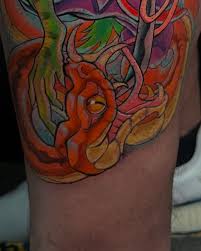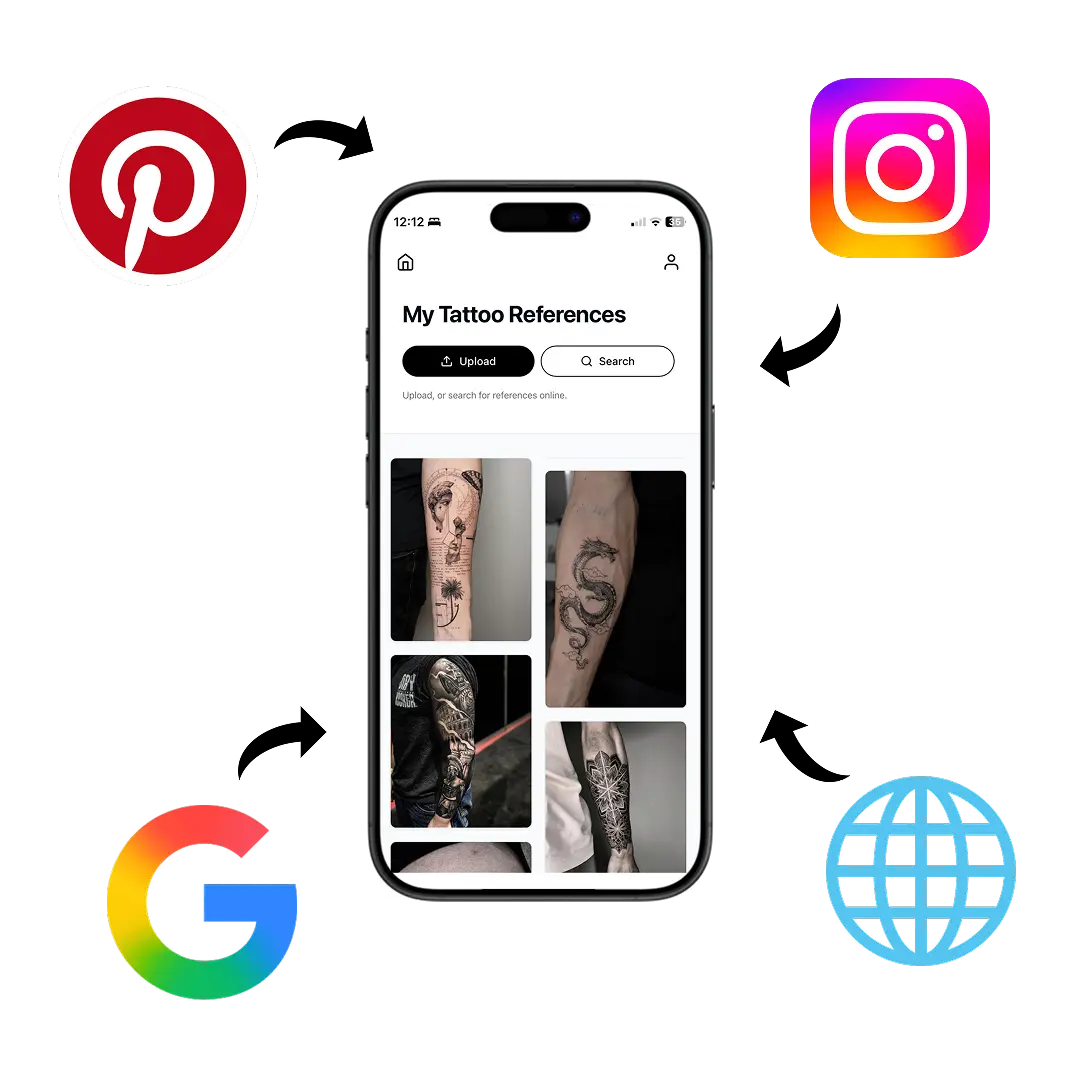New School Tattoo Ideas
Meaning of New School Tattoos
- New-school style tattoos are characterized by their vibrant colors, bold outlines, and exaggerated depictions, often drawing inspiration from pop culture and comic art.
- This style emerged in the late 20th century as a reaction to the traditional tattoo style, embracing a more playful and cartoonish aesthetic.
- Common themes in new-school tattoos include fantastical creatures, surreal landscapes, and whimsical characters, often with a humorous or satirical twist.
- The cultural significance of new-school tattoos lies in their representation of individuality and rebellion against conventional norms, appealing to those who seek to express their unique personality.
- Historically, new-school tattoos have roots in the punk and skateboarding subcultures, where they were used as a form of self-expression and identity.
- Unlike traditional tattoos, new-school designs are not bound by strict symbolism, allowing for more personal and subjective interpretations.
- This style is popular among both genders and can be placed on any body part, though larger areas like the back, arms, and thighs are often preferred to accommodate the intricate designs.
- New-school tattoos are often seen as a celebration of creativity and artistic freedom, making them a popular choice for those who appreciate bold and unconventional art.
6,121 Tattoo Ideas

Las cosas nuevas de nuestro artista @gio.tattooer Studio @enfoquetattoostudio . . . . . #tattoo #oldschool #traditionaltattoo #losteques #venezuela #loveart #passion #alemania #madrid #miami #medellin #caracas #dragon #tattoodragon #tatuaje #rosas
enfoquetattoostudio

Billy Ovalle Tatuajes(@animal_sinrostro) • Instagram 사진 및 동영상
animal_sinrostro

𝐒𝐚𝐦𝐦𝐲 𝐂𝐚𝐬𝐭𝐫𝐨 𝐀𝐫𝐭 | Así se vieron mis días tatuando en Madrid 🇪🇸✨ Quede enamorada profundamente de esta ciudad Mil gracias a @konohatattoomadrid por el... | Instagram
reel

Billy Ovalle Tatuajes(@animal_sinrostro) • Instagram 사진 및 동영상
animal_sinrostro

K A R B O N | M A D R I Z (@karbon.tattoo) • Instagram photos and videos
karbon.tattoo

April Bustamante | Algo un poco distinto, un camaleón en new school bien colorido para mi cliente❤️🔥 Citas y cotizaciones al 7114-5801 o por DM📩... | Instagram
april.ink_

Billy Ovalle Tatuajes(@animal_sinrostro) • Instagram 사진 및 동영상
animal_sinrostro

No hay palabras que puedan explicar lo mucho que me gusta esta polilla💖 este tattoo lo hicimos en un par de sesiones, el crisantemo y las hojas están sanas🫶🏽 mil gracias Hil,
april.ink_

Pablo “Colo” Barada es un tatuador argentino con más de 30 años de experiencia, reconocido internacionalmente por su maestría en el estilo japonés. Desde sus inicios en 1989, ha desarrollado una carrera
puratintafest

Adrian Nunes (@adrian_nltattoo) • Instagram photos and videos
adrian_nltattoo

GIGO • TATUADOR (@gigos_tattoo) • Instagram photos and videos
gigos_tattoo

Billy Ovalle Tatuajes(@animal_sinrostro) • Instagram 사진 및 동영상
animal_sinrostro

Billy Ovalle Tatuajes (@animal_sinrostro) • Instagram photos and videos
animal_sinrostro

Trabajo realizado para @ezeborstelmann en @insult_tattoo . 📍Si te gusto y te querés hacer algo así escribime 📩 Hecho en 5 hs de trabajo con pigmentos @drakkar_world_ink Insumos @nuestrohabitatwork Maquina @bronctattoo.official #tatuaje #
p

Manuel Medina ✏️ Tattoo/Cali | - Pulpo 🐙para el cuello de mi amigo @buchotattoo en su bonito espacio en Madrid 🇪🇸 (foto y video del segundo día) — Hecho con... | Instagram
brutalpain1

Pato Monte Grande (@patotattoomontegrande) • Instagram photos and videos
patotattoomontegrande

Con emoción, anunciamos la participación del maestro @dancordero como invitado de honor en nuestra primera edición. Este distinguido artista costarricense 🇨🇷 referente latinoamericano del tatuaje oriental, compartirá su visión única y experiencia
puratintafest

GIGO • TATUADOR | 2020 pandemia ,situación que me llevó a reinventarme en el tatuaje cuando todo estaba perdido . Eternamente agradecido con las personas... | Instagram
p

Partnered artist @cristopher_mendez_alfaro 🐙 #electrumink #neotradtattoo #neotraditionaltattoos #octopustattoo
electrum_ink

México Tattoo Convention | JEE SAYA, INVITADO ESPECIAL EN MTC2024 🇻🇪⚡ Artista multidisciplinario especializado en tatuaje, pintura y escultura. Originario de... | Instagram
mexicotattooconvention

Un chef, como un pulpo, tiene mil cosas en mente y siempre una mano (o tentáculo) ocupada en la cocina. 🐙👨🍳 Este tatuaje representa la pasión, la habilidad multitarea y el amor
shoocktattoostudio

Dennos pan pero también dennos rosas” 🌹🥐 tatuaje con un significado muy interesante #breadandroses #tattoo #perutattoo
coffintattoo

🔥 Expotattoo Zipaquirá corazón de acero 🔥 Te presenta los diferentes artistas que nos acompañarán este 18/19 de noviembre. En esta oportunidad tenemos el gusto de presentar a @tattoos_baku artista que nos
p

Pura Tinta Fest | Artista costarricense confirmado: @M__O__Y__A__ 🇨🇷 Este talentoso artista será parte de la segunda edición de Pura Tinta Fest este 28 de... | Instagram
puratintafest
One App to Store All Your Tattoo Ideas
Store your tattoo ideas in one place and Virtual Try-On them on your body!

See Your Design On Your Body
With the virtual try-on feature, you can realistically see how any design looks on your body. Save screenshot and share with your tattoo artist!



Cultural Considerations and Taboos for New School Tattoos
While new-school tattoos are generally well-received in many parts of the world, there are cultural sensitivities to consider. In some conservative societies, tattoos, in general, may be frowned upon or associated with negative stereotypes. Additionally, certain symbols or imagery might be culturally sensitive or offensive if not properly understood or respected. For example, using religious symbols or culturally significant icons in a new-school style could be seen as disrespectful if not approached with cultural awareness and sensitivity.
Popular Tattoo Styles and Variations for New School Tattoos
New-school tattoos are known for their versatility and creativity. Popular styles within the new-school genre include cartoon characters, fantastical creatures, and surreal landscapes. These tattoos often feature exaggerated proportions, bold outlines, and a vibrant color palette. Variations can include elements of graffiti art, with dynamic lines and a sense of movement, or comic book influences, with dramatic shading and expressive characters. The style allows for a high degree of personalization, making each tattoo unique to the wearer.
Historical Origins and Evolution of New School Tattoos
The new-school tattoo style emerged in the 1980s and 1990s as a reaction to the traditional tattoo styles that dominated the earlier part of the century. It was heavily influenced by the rise of hip-hop culture, graffiti art, and the punk rock movement, which all emphasized bold self-expression and breaking away from conventional norms. Artists like Marcus Pacheco and Aaron Cain were pioneers in developing this style, pushing the boundaries of what tattoos could represent and how they could be executed. The new-school style continues to evolve, incorporating digital art influences and new techniques.

